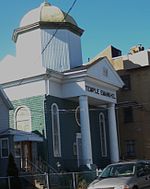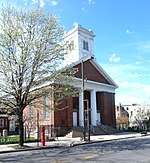Port Richmond High School

Port Richmond High School is a public high school on the North Shore of Staten Island, New York City, New York. It is located in the Elm Park neighborhood, at 85 St Josephs Avenue between Innis Street and Charles Avenue. It has approximately 100 full-time teachers and a student-to-teacher ratio of 21.5.The school serves grades 9-12, and offers JROTC, Business, Culinary Arts, Medical Technology, and TV Media specialty programs. Students eligible for the "Gateway to Higher Education" and "Collegiate Academy" Honors programs may take accelerated courses, and college-level Advanced Placement coursework. There are periods 0–9 in this school. Freshmen and Sophomores are usually 1–8. Period 0 is used for JROTC, and College Now classes where students can earn college credits. Two state-of-the-art STEAM Labs (Science-Technology-Engineering-Art-Math) opened in 2019, complete with access to Apple technologies, 3D printing and engraving, LEGO robotics, virtual reality, stained glass making, machining and woodworking.
Excerpt from the Wikipedia article Port Richmond High School (License: CC BY-SA 3.0, Authors, Images).Port Richmond High School
Saint Josephs Avenue, New York Staten Island
Geographical coordinates (GPS) Address Nearby Places Show on map
Geographical coordinates (GPS)
| Latitude | Longitude |
|---|---|
| N 40.634444444444 ° | E -74.142777777778 ° |
Address
Port Richmond High School
Saint Josephs Avenue
10302 New York, Staten Island
New York, United States
Open on Google Maps






